Far be it from me to tell anyone how to feel. If you don’t cry at the end of It’s a Wonderful Life, I’ll think no less of you. If your heart doesn’t skip a beat when Captain America picks up Mjolnir, who am I to judge? If you don’t double check your locks at night after reading And Then There Were None, that’s your business.
But if you make it through a whole game of Camel Up without shouting—whether in unbridled joy, deviant glee, or inconsolable disappointment—well I’ll have to wonder if you’re not missing a few muscle fibers in your ticker.
Without a doubt, the game that has seen our table the most—ever—is Camel Up from the team at Eggertspiele (Great Western Trail, Village). I don’t know what made Steffen Bogen choose camels (though it was likely something like this), but I am beyond grateful. I’ve seldom come across a game that is somehow a gateway to, and simultaneously, a repeated point of comfort on what can be a turbulent path through the highs and lows of an ever-evolving hobby.
Brace yourselves, for this is part review and part love letter. All thrill—without any of the slobber.
Abandon the need for control
Camel Up welcomes from three to eight players to the tracks to gamble on the camel race. Delightfully chunky, colorful camels make their way around a track (in one direction or another) over a series of Legs before eventually crossing the finish line to the elevation or ruin of would-be watchers.
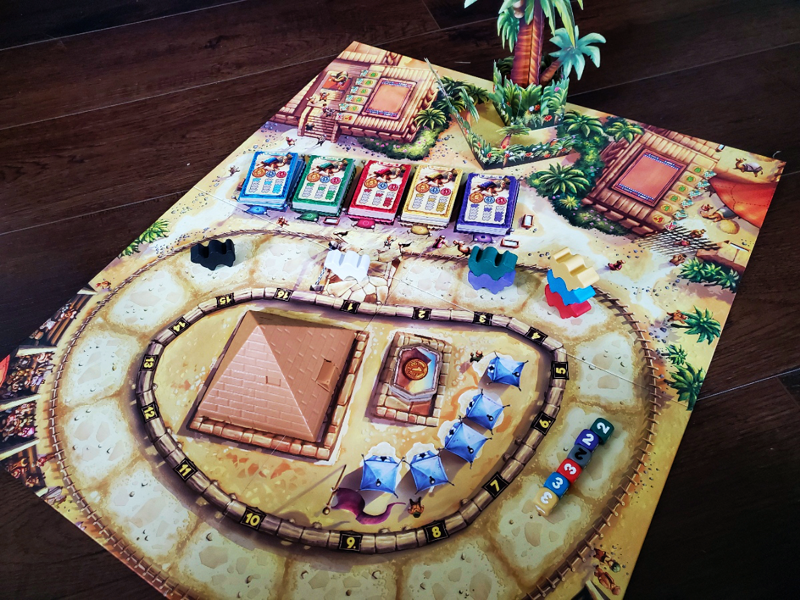
On a turn, players choose from one of four actions. The first option, and the most common among new players, is to Roll to increase everyone’s information by shaking the most marvelous tactile component in my game collection—the pyramid—and pressing the release to advance one color of camel from one to three spaces. Rolling also grants the player a chip worth one coin at the end of the Leg, which occurs after five dice are rolled. There are six dice controlling the seven camels, meaning not every camel will necessarily move in a given Leg.
One distinct feature of this camel race, however, is that there is only one footprint on each space. If camels land on each other, they land on each other, precariously stacking upward. The top camel is considered the leader of the stack.
A second distinct feature of this race comes in the black and white camels—the crazy camels—who are immediately disqualified in every race because they’ve chosen to travel backwards on the track. As these two loons make their way around, they introduce an avenue for unexpected changes to the landscape, because any camels that stack atop their backs could potentially carry the leaders away… in the wrong direction.
Based on the information available, players may bet on the Leg by selecting a token representing their favorite’s color. There are four tokens for each camel which pay less at the bottom than the top, meaning the first player to bet on a camel in any given leg will potentially receive the highest payout. After each fifth die is rolled, the Leg is scored according to the camel position, paying out the first and second place racers. Any other bets exact a cost in coins. Once the Leg is scored, the dice are returned to the pyramid.

With any turn, players may bet on the Overall result by predicting a camel to finish either in first or last place. Players receive one card for each camel which must then be used judiciously and shrewdly. Timing is everything here, because the bets pay out according to when they were submitted, with the first correct bet yielding the highest coin count. Incorrect bets, once again, carry a penalty. These cards are scored once the first camel crosses the finish line—after scoring the final Leg, that is.
Finally, players may cast their Cheer/Jeer token to the track to deal a blow to the fate of the dice. One side causes camels to bump forward by a space, the other causes them to bump backward. If a camel lands on the space, the player receives a coin as a bonus, but that’s just a cherry on top. The real joy is in messing with the race.
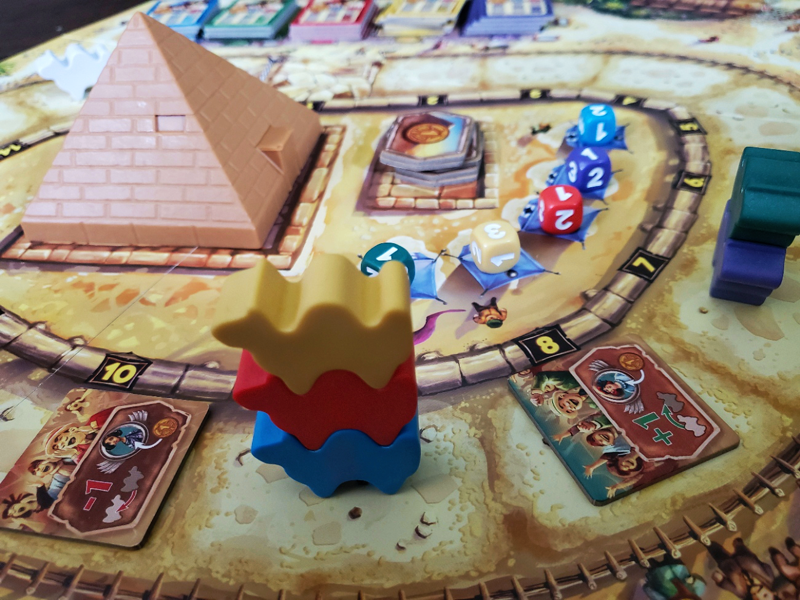
The devious joy of the Cheer token comes when a camel is forced backward into a stack, at which point they are sent not to the top but the bottom. This means a camel that would have jumped off the top of the stack into a potential lead could fall two, three, four, or more spots in one fell swoop, shifting the dynamics of the race completely.
Why on earth would someone do this, you ask? Well if Colonel Mustard (forgive me for using our family names for the camels) is in second and I’m holding the best Leg token for yellow, I might drop my jeer on the track to potentially get Big Red out of the way… especially if everyone has bet heavy on Big Red. Aside from the strategic value, some folks drop cheers and jeers just to watch the world burn. There’s one in every crowd. Camel Up will find them.
In a game with six or more players, one additional option comes to the table in the form of Partnerships. Players can force a partnership on another gambler by exchanging a handshake card. This card allows each player involved to share their top gain in the Leg. Though this may seem unnatural, it is a lovely balancing mechanic in a Leg where players may only get one or two turns, or where the best and (seemingly) most obvious bets are taken early.
Once the race ends, folks can celebrate their gains as the overall bets are scored before the gambler with the most money assumes a gloating posture in victory.
…and embrace the chaos
Camel Up begins in medias res with a roll of all the dice. This little feature says much about the ethos of the game. It begins in the midst of the action and the action just keeps unfolding. Sure, the first roll or two might not set wigs on fire around the table, but if players are even mildly invested in a particular camel, they will express their feelings. Personally, I like dropping an overall bet on a camel early just so I have something to care about. When Grimace jumps to an early lead just like I thought he would, I enjoy the emotional workout. When Sully falls behind and tramples my heart, I want to have strong words with the imaginary jockey afterward.
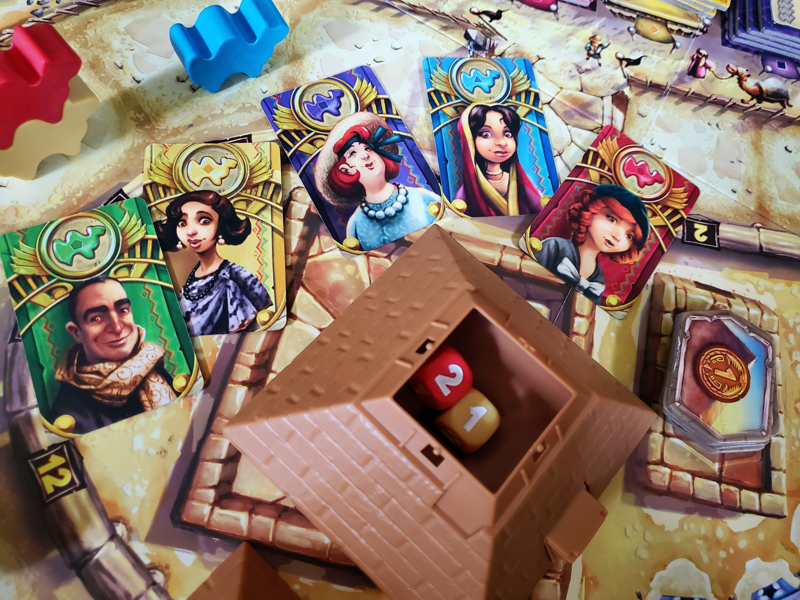
Even though the camels move by rolls of the dice, the outcome of Camel Up is far from random. Players win by managing the information on the track, not by whipping their camels into a slobbery mess. Because each camel is represented only once on the dice in the great pyramid, each roll eliminates something else that can happen in the Leg. The first roll may not say much, but the third or fourth roll says much more before the fifth seals it. The key is combining the right amount of interpretation with a hint of insight. It helps to know that Hunter is just a loser.
This is the sort of game that beautifully bridges the gap from ventures of pure luck by introducing a touch of human agency to the process. But as I’m a firm believer that luck is one of the most important mechanisms in creating excitement, I love that there is enough uncertainty to make the results agonizing in all the best ways. Camel Up replicates the very real roller coaster of a gamble without any of the sorry-you-lost-your-house-and-car consequence. What more could you ask?
I’m almost ashamed that I’ve come this far without mentioning the game board. The pop-up game board. Let me say that again. The pop-up game board!? There’s nothing like sitting down with a first time player and unfolding the palm tree toward the sky in all its glory to let them know that they’ve sat down to a worthy experience. Coupled with those weighty camels, the intoxicating pyramid, the cheesy plastic coins, and the various bits and cards, the board is a well-utilized canvas for the display of Chris Quilliams’s ridiculously fun art.
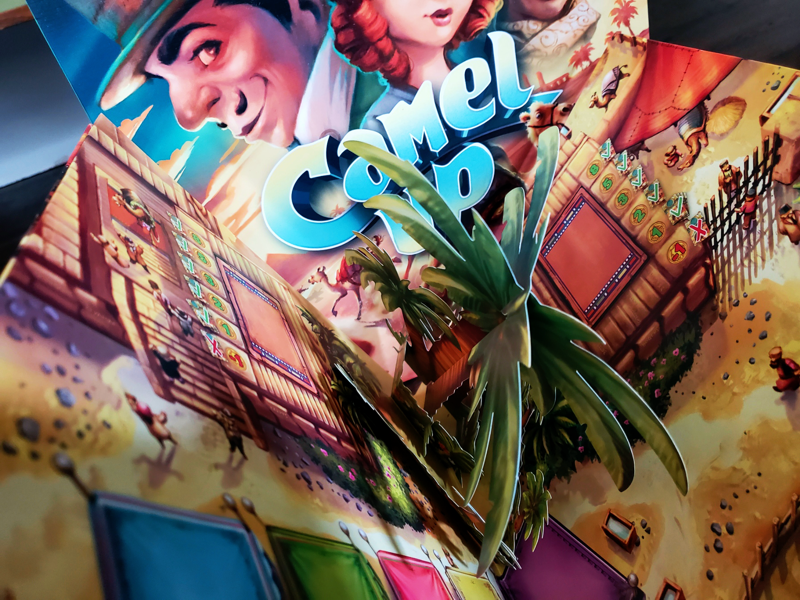
Call me biased. Say I have an uncritical eye, but there is not a single aspect of Camel Up that I would change. I’ve known nothing but raucous joy and laughter with this title. We take it with us almost everywhere we go in hopes that folks will get bored so we can brighten their lives. The extended family isn’t shy about sending dirty looks our way if we happen to forget it for a long weekend.
I’ve not played the expanded first edition. My entire experience is with the second, and I would look no further than this total package, if you can find it. It’s one of the rare games I watch the stores for, just so I can give it to someone. I’ve thought of buying a second copy for when we inevitably wear out the pyramid. Even the non-gamers almost universally look for it online immediately after their first game.
I only hope I’ve described Camel Up well enough to set you on the hunt. May the dice and your subsequent logic be ever in your favor, and may your favorite knock-kneed racer ride to unending glory, lining your pockets with nonlegal tender.


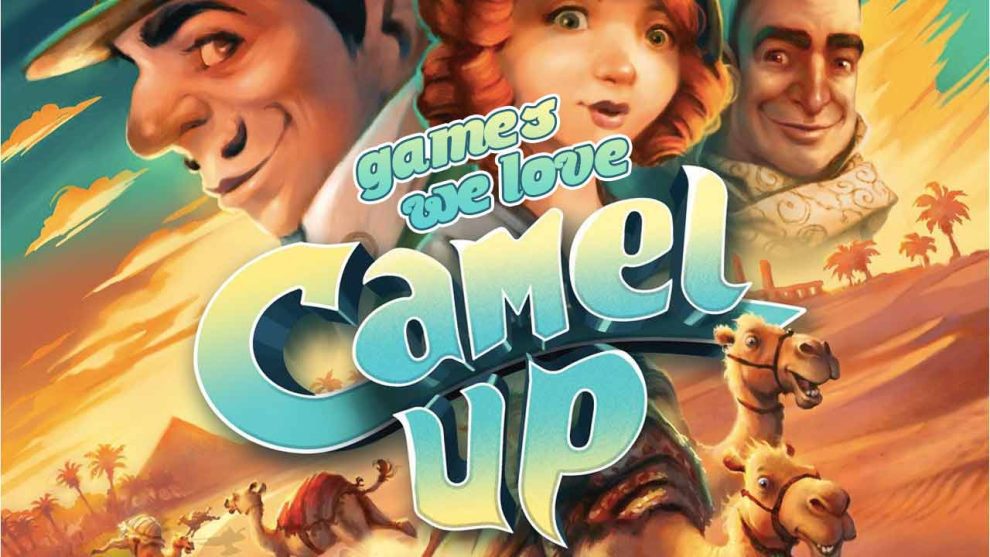








Add Comment